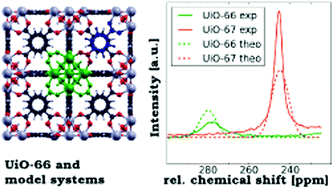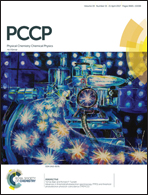The origin of the measured chemical shift of 129Xe in UiO-66 and UiO-67 revealed by DFT investigations†
Abstract
The NMR chemical shift of the xenon isotope 129Xe inside the metal–organic frameworks (MOFs) UiO-66 and UiO-67 (UiO – University of Oslo) has been investigated both with density functional theory (DFT) and in situ high-pressure 129Xe NMR measurements. The experiments reveal a decrease of the total chemical shift comparing the larger isoreticular MOF (UiO-67) with the smaller one (UiO-66), even though one may expect an increase due to the higher amount of adsorbed Xe atoms. We are able to calculate contributions to the chemical shift individually. This allows us to evaluate the shift inside the different pores independently. To compare the theoretical results with the experimental ones, we performed molecular dynamics simulations of Xe in the MOFs. For this purpose, the pores were completely filled with Xe to gain insight into the distribution of Xe at high pressures. The resulting trend of the total shift agrees well between the theoretical predictions and the experiments. Moreover, we are able to describe specific contributions to the total shift per pore, explaining the experimental behavior at an atomistic level.



 Please wait while we load your content...
Please wait while we load your content...